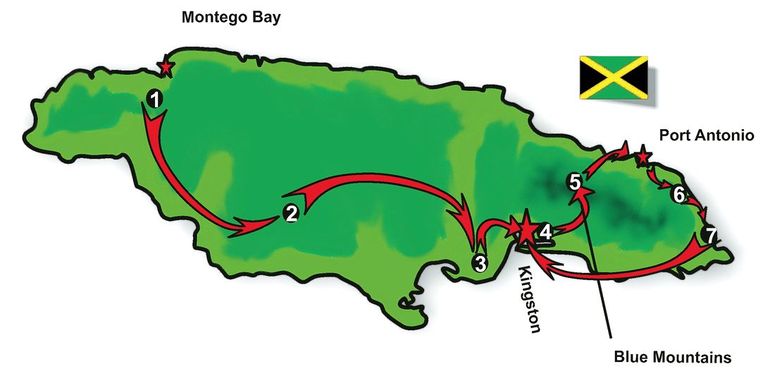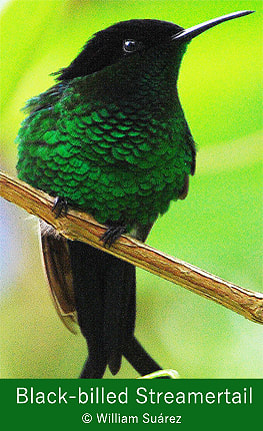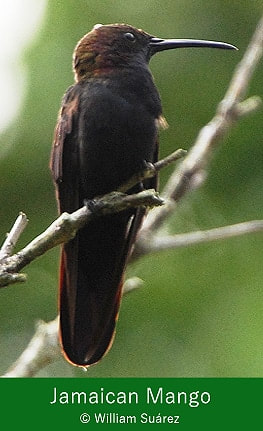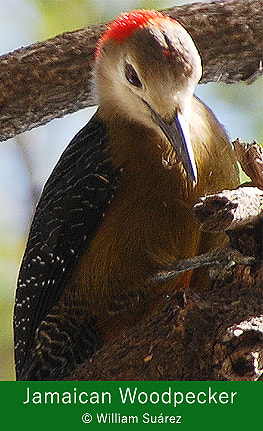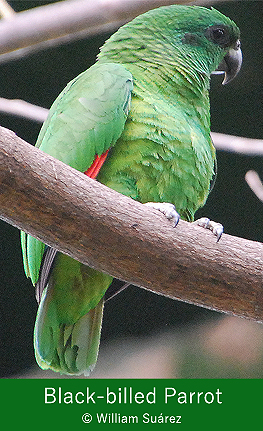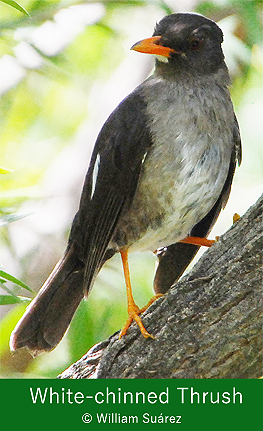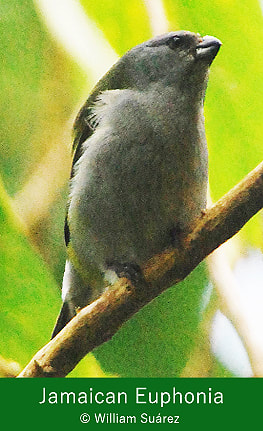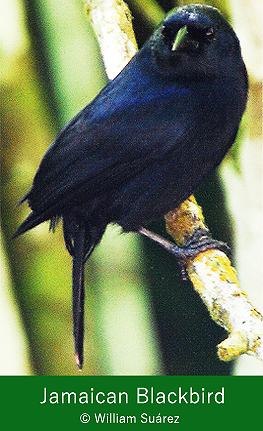<< JAMAICA BIRDING TOURS
The Jamaica Birding Tour! A birdwatching excursion to an amazing island in the Caribbean, where the scenery is stunning and most of the endemic birds are still present! Jamaica Birding Tours
Quick Info Literature & Audio Photo Gallery Bird Checklist COVID-19
|
Jamaica ("Xaymaca") is the third largest land mass in the Caribbean, after Cuba and Hispaniola. This beautiful and magical island, rich in nature and culture and the birthplace of reggae music, is located in the Caribbean Sea roughly south of and between southeastern Cuba and western Hispaniola (Haiti). Mountain ranges, including the exuberant Blue and John Crow Mountains in the eastern region, dominate the topography. Blue Mountain Peak (7,402 ft/2,256 m) is the highest point in Jamaica.
The endemic birds of Jamaica are the result of the complicated evolution that took place in the West Indian islands. The best examples are the beautiful Jamaican Tody, Todus todus, and the probably-extinct Jamaican Pauraque, Siphonorhis americana. The avifauna of Jamaica comprises about 319 species, including 4 endemic genera, 28 endemic species (or 29, according to some authorities), and about 20 endemic subspecies, plus numerous regional specialties and wintering species from North America (see Bird Checklist). This reflects one of the highest levels of endemism in the Antillean Subregion. Today, 28 of these extremely interesting endemic bird species can be found during our ornithological explorations throughout the island, including the national bird of Jamaica: the Red-billed Streamertail ("Doctor Bird"), Trochilus polytmus. Two Streamertail species (considered subspecies by some authorities) are distinguished by their bill color. The commonest species is called Red-billed Streamertail because of its coral red bill. It inhabits most of the island, where it is common, whereas the Black-billed Streamertail (T. scitulus) is restricted to a region in eastern Jamaica. Our birding tours in Jamaica (see map) starts at Montego Bay, located in northwest Jamaica, and ends at the capital city of Kingston, in the southeast. We visit localities with the highest biodiversity and therefore, richness of avifauna, both in terms of endemism and species numbers. We will explore most of habitats, birding in forests from high elevations in mountain ranges, to foothills, and also in lowlands, deserts, lakes, mangroves, and coastlines. Some early morning starts are necessary and there is a night (or more) birding session as well. |
Jamaica
Main Localities: 1) Rockland's Bird Sanctuary, 2) Marshall's Pen, 3) Hellshire Hills, 4) Botanical Garden, 5) Hardwar Gap, 6) Ecclesdown Road, 7) Hector's River
DAY 1: Welcome to our Birding Tours to JamaicaArrival in Montego Bay Angster International Airport (MBJ). We will be waiting for you at the airport for your transportation to the hotel, where members of the group will check into their reserved rooms. At 6:00 p.m. participants will meet the leader in the lobby for a welcome meeting and discussion of our Jamaican birding trip plans before dinner. Night in Montego Bay.
DAY 2: Rockland's Bird Sanctuary & Marshall's PenAfter our breakfast at the hotel, we will drive south a short distance to visit the Rockland's Bird Sanctuary (or "Rockland's Feeding Station"), where we will have one of the most beautiful experiences with Jamaican birds, especially hummingbirds. During our morning in this magical and relaxing locality, you can have the unique experience of having a Jamaican Mango and/or a Red-billed Streamertail ("Doctor Bird") perched on your fingers while feeding. Other possible species here include White-crowned Pigeon, Ring-tailed Pigeon, Caribbean Dove, White-winged Dove, Smooth-billed Ani, Antillean Palm-Swift, Vervain Hummingbird — the second smallest species of bird in the world — Jamaican Tody, Jamaican Woodpecker, Olive-throated Parakeet, Jamaican Elaenia, Jamaican Pewee, Sad Flycatcher, Rufous-tailed Flycatcher, Loggerhead Kingbird, Jamaican Crow, Bananaquit, Yellow and Black-faced Grassquit, Orangequit, Jamaican Oriole, Jamaican Euphonia, among others.
After our "magic moment", we will depart to our next destination, Marshall's Pen, near the hills of Mandeville (central Jamaica). There we will conduct our afternoon birding session of the day, including the first search for the Jamaican Owl. This 300-acre (121 hectare) property is today owned by well-known biologist Ms. Ann Sutton. It was once a cattle ranch and a coffee plantation, and formerly an aboriginal Taino site, as well. It is a designated National Heritage Site which combines history, Ms. Sutton's hospitality, and excellent homemade food. In addition, it is very special for birding activity, as most of the Jamaican endemic birds can be found here. Birds at Marshall's Pen include White-crowned Pigeon, Ruddy Quail-Dove, Caribbean Dove, Zenaida Dove, Mangrove Cuckoo, Chestnut-bellied Cuckoo, Jamaican Lizard-Cuckoo, Smooth-billed Ani, Northern Potoo, Antillean Palm-Swift, Jamaican Mango, Vervain Hummingbird, Red-billed Streamertail, Jamaican Tody, Jamaican Woodpecker, Olive-throated Parakeet, Jamaican Elaenia, Jamaican Pewee, Sad Flycatcher, Rufous-tailed Flycatcher, Loggerhead Kingbird, Jamaican Becard, Jamaican Vireo, Cave Swallow, White-eyed Thrush, White-chinned Thrush, Arrowhead Warbler, Bananaquit, Yellow and Black-faced Grassquit, Orangequit, Yellow-shouldered Grassquit, Jamaican Spindalis, and more (including migrant wood warblers). Night in Marshall's Pen. DAY 3: Marshall's Pen & south arid regionAfter breakfast, we will continue exploring and relaxing at Marshall's Pen during the morning. After lunch (and saying thanks to Ms. Sutton one more time), we will drive southeast, heading to Hellshire Hills, and into the arid south region of Jamaica. Our target bird here will be the endemic subspecies of the Bahama Mockingbird, which is a relict found only in this arid region of the island. During our search for this Antillean specialty, we may also find other very interesting species such as the Jamaican Pewee, Sad Flycatcher, Stolid Flycatcher, Loggerhead Kingbird, Orangequit, Greater Antillean Bullfinch, among others. Finishing our ornithological explorations at this locality, we will depart to the capital city. Night in Kingston.
DAY 4: Royal (Hope) Botanical Garden & Blue MountainsAfter breakfast and check-out at the hotel, we will explore the grounds of the Royal (Hope) Botanical Garden, said to be the largest garden in the Caribbean. Because the variety of habitats provided by this green space are within the urban confines of the city, it is an exceptional locality for some of the beautiful endemic birds of Jamaica. It is a special place to obtain good views of the two endemic species of parrots: Yellow and Black-billed Parrot, our target birds at this locality. Other birds in the garden include Jamaican Tody, Vervain Hummingbird, Jamaican Mango, Red-billed Streamertail, Olive-throated Parakeet, White-chinned Thrush, and others.
As soon as we finish at the botanical garden with our target birds, we will travel into the Blue Mountains, a designated Important Bird Area in the eastern part of the island. Our specific destination is the mature montane forest at Hardwar Gap, where we will have our lunch and will be birding during the afternoon. The richness of the bird fauna, as part of the majestic biodiversity here, makes this locality one of the prime Jamaican birding sites. Night near Hardwar Gap. DAY 5: Hardwar Gap & Port AntonioA pre-breakfast birding session will be conducted in Hardwar Gap (3,937 ft/1,200 m). Our target birds here will be the bicolored and endemic Arrowhead Warbler, one of the West Indian species that superficially resembles our Black-and-white Warbler. Another will be the interesting Jamaican Blackbird, one of the most endangered species in Jamaica. This bird is a specialist in obtaining food from bromeliads and other plants and is unusual among blackbirds in being monogamous. Along the Hardwar Gap we also have opportunities for good views of other endemics such as the Ring-tailed Pigeon, Crested Quail-Dove, Chestnut-bellied Cuckoo, Jamaican Lizard-Cuckoo, Jamaican Tody, Blue Mountain Vireo, White-chinned Thrush, White-eyed Thrush, Jamaican Becard, Rufous-tailed Flycatcher, Jamaican Elaenia, Jamaican Spindalis, Bananaquit, Yellow-shouldered Grassquit, Orangequit, Jamaican Oriole, and the secretive and endemic subspecies of the Rufous-throated Solitaire.
After breakfast and obtaining good views of our target birds during the morning, we will drive to our next hotel, located in the vicinity of Port Antonio, on the extreme northeastern coast of Jamaica. During our travel through the mountains we will be checking different spots in towns and patches of forested areas. Near Port Antonio and on the hotel grounds, we will have additional views of common species of birds such as Jamaican Mango, Black-billed Streamertail, Jamaican Woodpecker, Olive-throated Parakeet, Loggerhead Kingbird, Bananaquit, Jamaican Oriole, Greater Antillean Grackle, and some of the migratory warblers. Night near Port Antonio. DAY 6: John Crow Mountains & Hector's RiverThis will be our last birding day and we will be birdwatching at the base of the John Crow Mountains, another designated Important Bird Area. We will bird along the beautiful and famous Ecclesdown Road, in the Drivers River Valley. The lushness of pristine wet forest makes this area one of the best for endemic birds on the island. This locality is productive, especially for species such as Crested Quail-Dove and Jamaican Blackbird, but also for Ring-tailed Pigeon, Yellow and Black-billed Parrot, Jamaican Lizard-Cuckoo, Chestnut-bellied Cuckoo, Jamaican Woodpecker, Jamaican Pewee, Jamaican Crow, Yellow-winged Grassquit, Orangequit, Jamaican Euphonia, and others.
After lunch, we will search the coastline, especially the Hector's River area, to enjoy the elegancy of the White-tailed Tropicbird, which might be seen nesting on coastal cliffs (this species will not be observed during some tours conducted outside of the breeding season). At the end of the day we will return to the capital city of Kingston, and to our hotel in Port Royal (in the Palisadoes), at the mouth of the Kingston Harbor. Port Royal possesses a fantastic and amazing history related to the "golden age" of the pirates in the Caribbean. Night in Port Royal. DAY 7: Departure & Good-bye to JamaicaEarly morning it will be possible to observe some of the sea birds and shorebirds present on the peninsula where the hotel is located. Day of transfer from the hotel to the Norman Manley International Airport (KIN) for departures of the members of the group.
|
Alterations in Tour Itineraries: Owing to a variety of circumstances, a planned itinerary as appears on this website, can be changed or modified locally by the leader to accommodate particular weather conditions, bird activity, human disturbances, unexpected situations, or any other reasons considered by the leader. WILLIAM SUAREZ BIRDING TOURS reserves the right to change any itinerary.





